Web Design Statistics: How Many Web Designers Are There?
There are over 1.88 billion web pages on the internet. If you want your website pages to stand out from the crowd and get noticed, it’s important to make sure you nail the design.
In this post, we’ll be looking at over 50 eye-opening web design statistics that shed some light on what consumers expect when it comes to web design and reveal some of the biggest mistakes website designers make.
These stats will also tell us more about the state of the web design industry this year, including the number of professional web designers out there, the average costs involved in building a website, and more.
Ready? Let’s get started.
Web design statistics (top picks)
- There are almost 27 million web developers worldwide
- 40% of consumers said that images were the most important design element of a website
- 84.6% of industry professionals believe an overcrowded website is the most common mistake when it comes to web design
- 88.5% of people say they’d leave a website that loads slowly, showing the importance of prioritizing website speed
- 26% of consumers prefer the use of primary colors in website design and 46% prefer blue
- Web visitors spend 57% of their time reading elements above the fold
How many web designers are there?
No exact figure is available about how many web designers there are worldwide. However, according to Statista, more than 24.5 million people are working in the development industry worldwide.
This includes web designers, front-end web developers, and back-end developers, and many professionals are multi-skilled in these areas.
In addition, Statista predicts the number of web designers will continue to grow in the next few years, and the number of development professionals will reach 28.7 million.
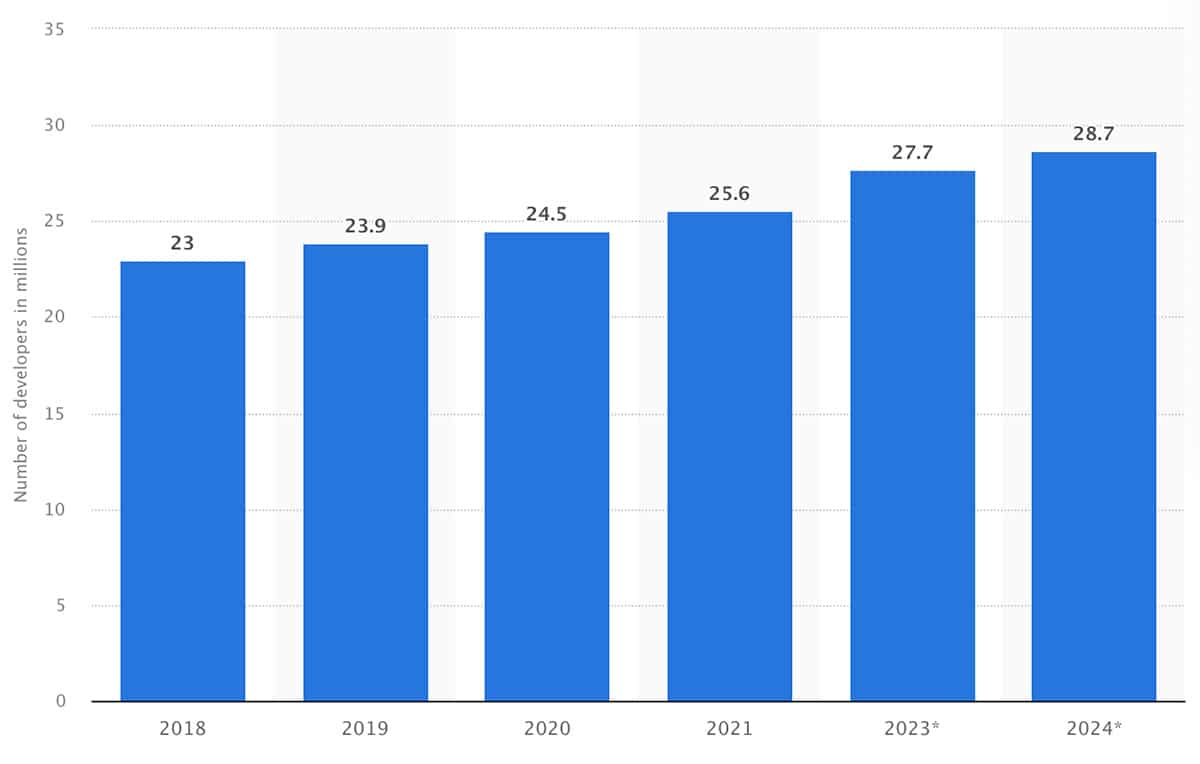
How many web designers are there in the US?
According to a study carried out by Zippia, over 84,040 web designers are working in the USA. The study also found that these designers were 45% more likely to work for public companies than private companies.
Key web designer demographic statistics
Here are a few key statistics relating to web designer demographics in the US:
- Most web designers (62.3%) in the US are men.
- 76.1% of US web designers are white
- 73% of web designers are over 30
- 67% of web designers have a bachelor’s degree
How much do web designers earn?
Web designers’ salaries can range from as little as a few thousand dollars a year, to upwards of $50,000. Here’s a breakdown of the average web designers’ annual salaries in countries around the world:
- USA – $50,900
- UK – $36,875
- India – $4,600
- Switzerland – $63,546
Some of the highest-paid roles are in western countries like the US, Denmark, Germany, Australia, and Switzerland. However, salaries in developing countries like India, Indonesia, Kenya, Egypt, and Argentina are much lower.
Sources: Hongkiat, Zippia, Statista
How much is the web design market worth?
The US web design services market is currently around $11 billion, while the global web design builder market is worth $1.6 billion.
The web design services market has been in decline for the last 10 years, but the web design builder market is growing rapidly.
Web design services market size (US)
According to IBISWorld, the web design services industry generated 11 billion in revenue in 2022. This is 1.9% less than the previous year, which suggests the market is declining.
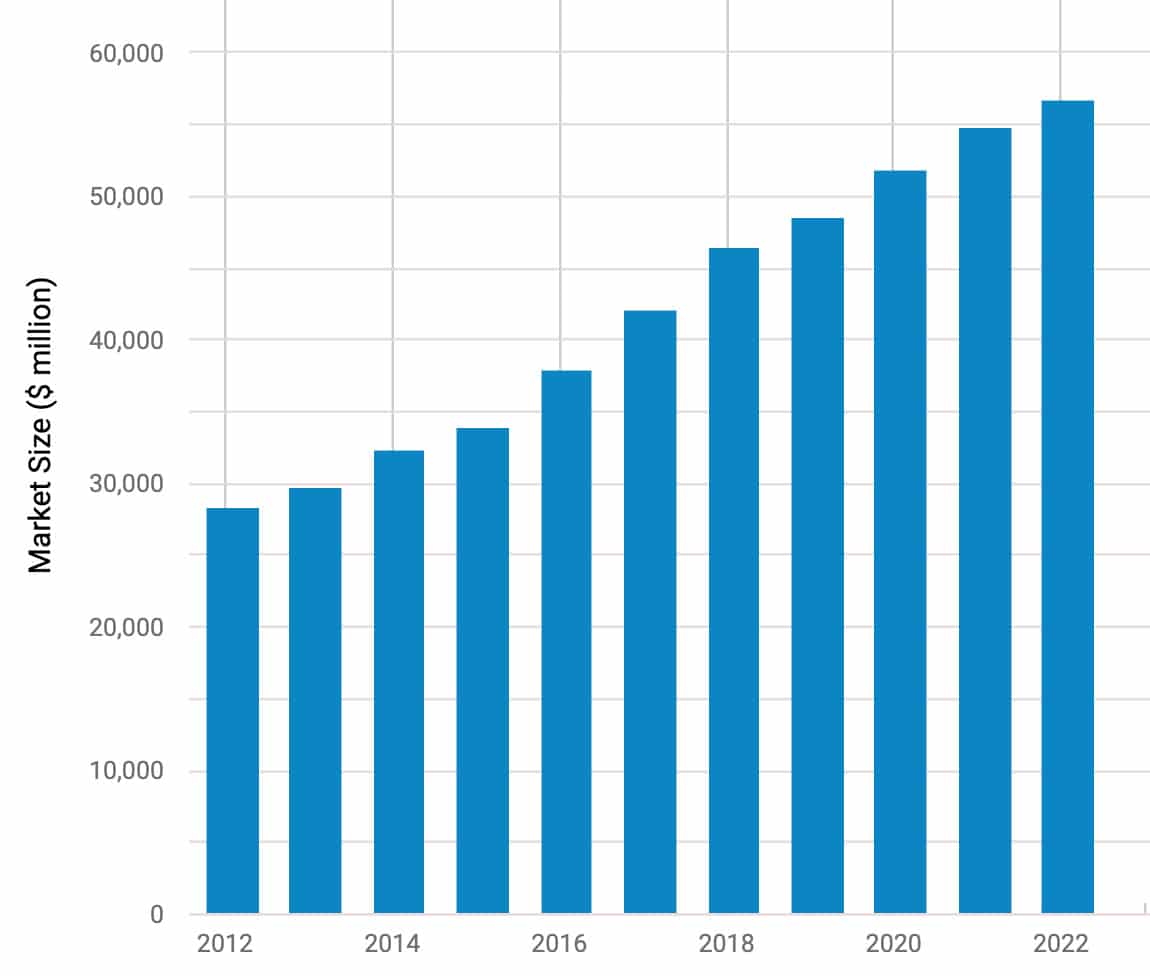
Web design services market growth over time (US)
The US web design services market had negative growth of -1.9% in 2022, and an annualized market size negative growth of -3.1% from 2017 to 2022. Here’s a year-over-year breakdown:
- 2022: 11 billion
- 2021: 11.2 billion
- 2020: 11.6 billion
- 2019: 12 billion
- 2018: 12.5 billion
- 2017: 12.9 billion
- 2016: 14.5 billion
- 2015: 16.2 billion
- 2014: 19.2 billion
- 2013: 22 billion
- 2012: 26.2 billion
As you can see, the market has steadily declined for the last decade.
Website builder market size
The global market size for website builders was estimated at around $1.6 billion in 2020. However, this is predicted to grow at a CAGR of 8.8%, reaching $2.9 billion by 2027.
Interestingly, this shows that while the web design services market is in decline, the website builder market is growing. This may reflect a wider shift in web design, in which businesses are increasingly likely to build their own website using software than hire a professional.
Sources: IBISWorld, Research and Markets
How important is web design?
Let’s take a look at some more stats relating to the importance of web design.
How does web design impact brand perception?
A company’s website is often the first customer interaction with their business. A study published by ResearchGate indicates that around 94% of first impressions are design related.
Not only that, but PR Newswire also published a study that indicated that 50% of internet users find web design to be a crucial factor when formulating an opinion about a company.
If you want to give off a good first impression, focus on creating an attractive, engaging website experience that reflects your brand values.
How long does it take for users to form an opinion about your website?
When visitors reach your website, you have an alarmingly small window to make a good impression and grab their attention.
According to a study conducted by Behavior and Information Technology, it only takes 0.05 seconds for users to form an opinion of your website and by extension, your brand.
And remember—those first impressions matter. If they form a negative opinion within that first fraction of a second, it’ll hurt your bounce rate and dwell time, and damage your brand credibility.
How does web design impact business credibility?
When users come across your website online, it’s important to show them you’re a credible business that can be trusted early on. In an age of scams and viruses, consumers are wary of visiting sites that look like they could pose a security risk.
A poorly designed website can make you look untrustworthy, with studies showing that 46% of users believe that a website’s design is the number one factor in determining a business’s credibility.
Sources: Adobe, John Waters, Behaviour and Information Technology, ResearchGate, PR Newswire
How much does web design cost?
The average cost of designing a website is $3200, according to a survey of web design agencies by GoodFirms. However, costs can vary substantially depending on the firm and the client’s needs.
How much do web design firms charge?
- 35.1% of surveyed web design companies charge between $1000 and $1500
- 24.3% of surveyed web design companies charge between $2000 and $2500
- 16.2% of surveyed web design companies charge $3000
- 10.8% of surveyed web design companies charge $4000
- 13.5% of surveyed web design companies charge between $5000 and $6000
What factors impact the cost of web design?
Most web design firms offer custom quotes as the cost usually depends on the nature of the project. With that in mind, GoodFirms asked agencies what factors they consider when pricing their services.
Over half of respondents (61.5%) said features and functionality were the main factors that impacted the cost. Here’s a complete breakdown of the survey results:
- 61.5% said features and functionality
- 46.1% said UI/UX design
- 46.1% said mobile responsiveness
- 34.6% said the content management system (CMS)
- 34.6% said usability & navigation
- 30.7% said the content list
- 19.2% said SEO
- 19.2% said third-party integrations
Top reasons for hiring a web designer
According to the same survey, small businesses chose to hire a professional web designer or design company (rather than building it themselves) because they wanted a completely customized website.
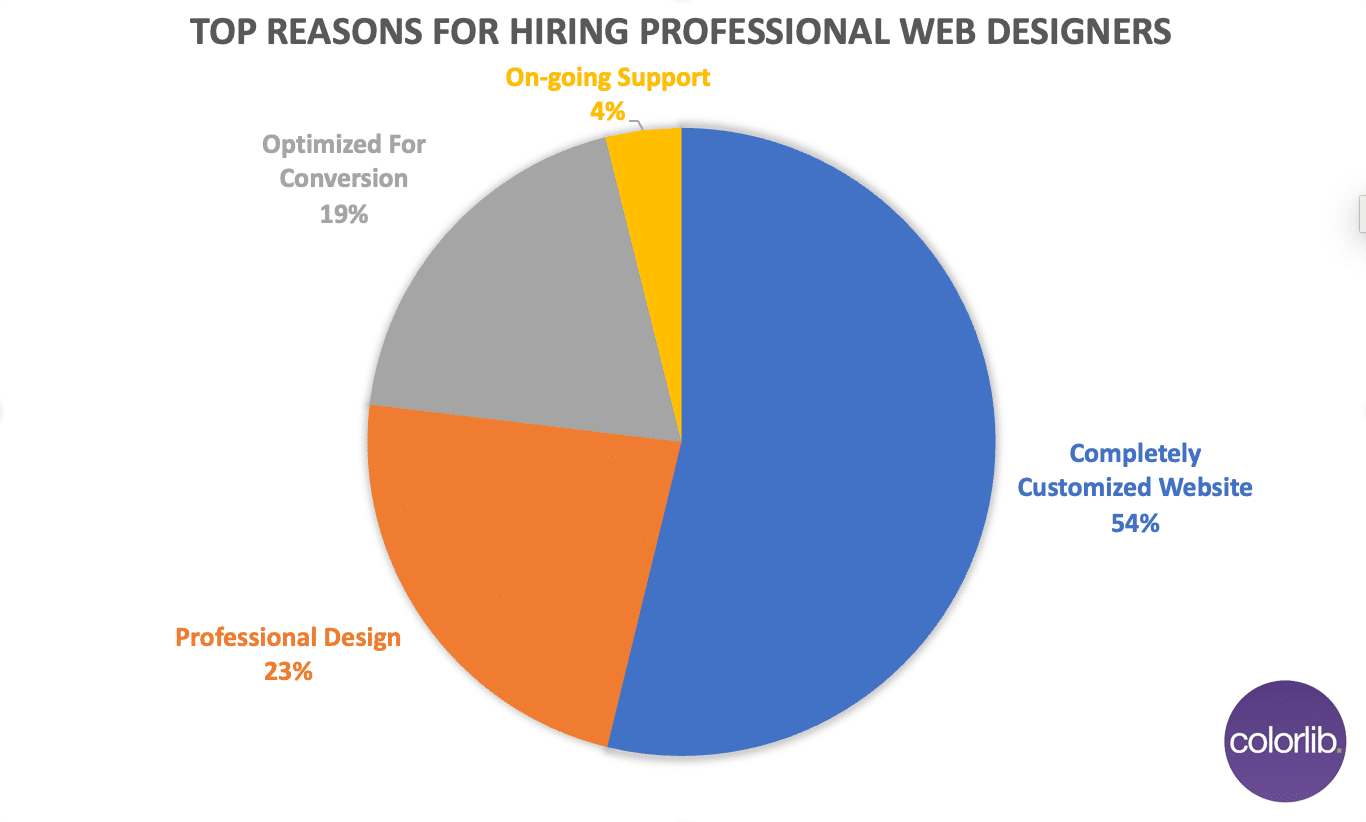
- 53.8% said they hired a web designer for a custom website
- 23.1% said it was because they wanted a professional design
- 19.2% said it was because they wanted a site that was optimized for conversions
- 3.9% said it was because they wanted on-going support
Top reasons companies redesign their website
The main reason companies choose to redesign their existing website is to fix a low conversion rate, according to surveyed businesses. Over four-fifths (80.8%) of respondents cited this as their top reason.

Other reasons include:
- High bounce rate – 65.4%
- Needs better UX – 61.5%
- Not responsive – 53.8%
- Outdated – 38.5%
- Not SEO-friendly – 23.1%
How long does it take to design a website?
80.7% of surveyed companies said it took a month to design their website. A further 24.3% said it took 1.5 months, 27% said it took 2 months, 7.5% said 2.5 months, and 11.5% said 3 months.

Sources: GoodFirms
What software do web designers use?
Most websites are built on WordPress, which suggests this is the software most web designers use. Additionally, web designers also rely on other UX/UI design tools including Adobe products like Photoshop, Illustrator, and InDesign.
What’s the most popular website builder?
WordPress is the most popular website builder by market share. It’s used by 43% of all websites and has a content management system (CMS) market share of over 64%, according to data from W3Techs.
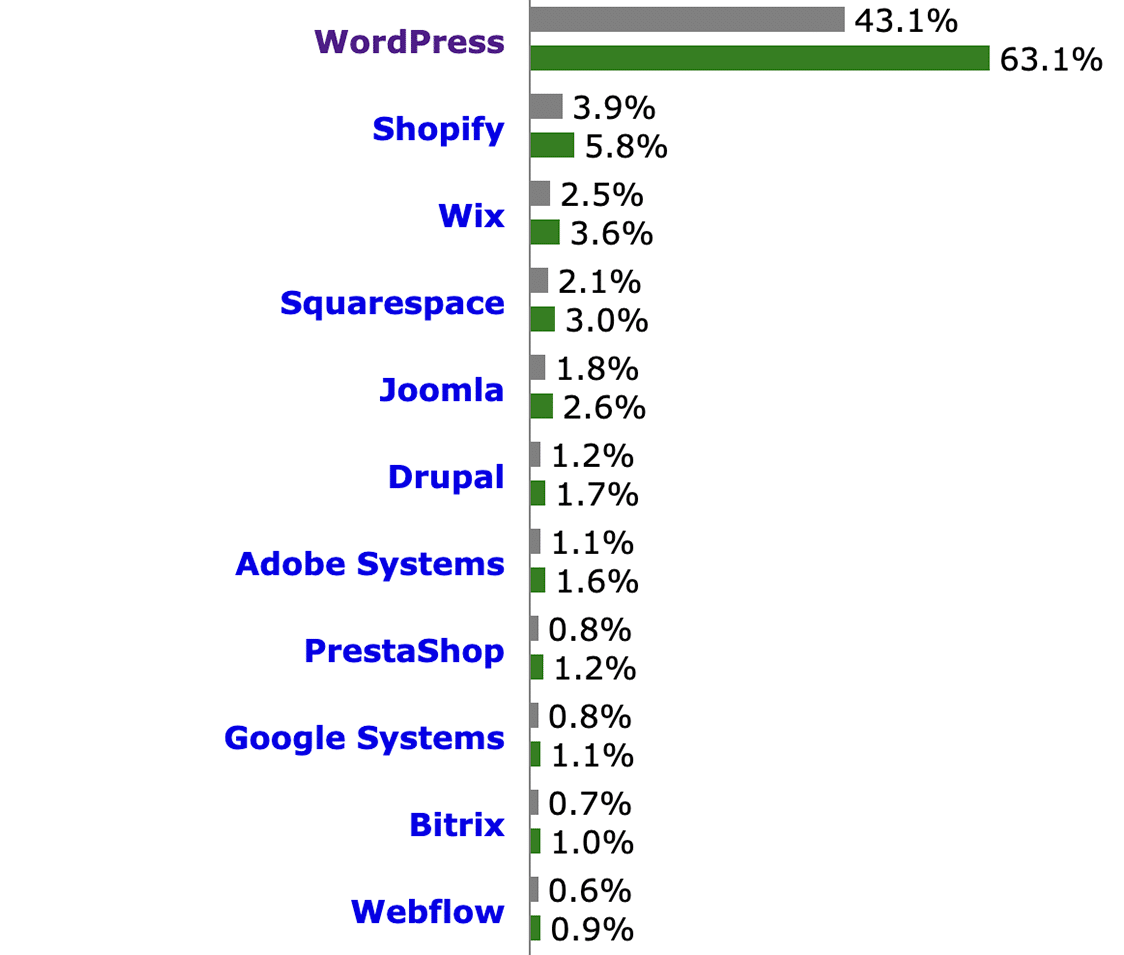
Top CMS / website builders by market share
- WordPress – 64.3% (More WordPress statistics)
- Shopify – 6.1%
- Wix – 3.4%
- Squarespace – 2.9%
- Joomla – 2.4%
- Drupal – 1.8%
More in-depth stats on content management systems are available here.
What tools do web design teams use?
According to GoodFirms, 88.5% of web design teams use Adobe Photoshop. Other Adobe products were also popular: 76.9% used Illustrator and 23.1% used InDesign. Sketch was used by 75% of web designers.
What are the latest web design trends?
Flat Design is the biggest recent trend in web design according to 88.5% of surveyed web designers. Flat Design involves taking a minimalist approach to web design and is characterized by simple 2D UI elements and bright colors. It’s all about usability.
Other popular trends identified include:
- Expressive typography – 61.5%
- Broken grid layouts – 38.5%
- Virtual reality video – 26.9%
- Voice search – 23.1%
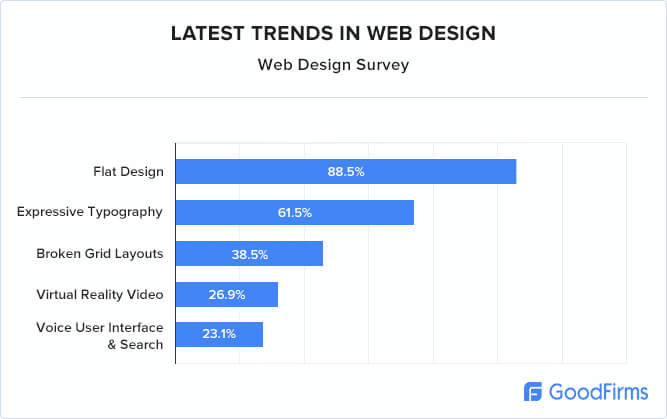
What does good web design look like?
Next, let’s look at some web design statistics that tell us more about what consumers value regarding website design and highlight some best practices.
What web design elements are most important?
According to Top Design Firms 2021 survey, the three most important visual elements to website visitors are images, color, and videos.
- 40% of consumers said that images were the most important element
- 39% said color was the most important
- 21% voted for videos as the most important design element
When creating your website, you’ll definitely want to focus on getting these three elements right. However, you should also consider the overall layout, cohesiveness, and content.
What are the best colors to use on your website?
26% of consumers say they prefer primary color schemes, and 46% of customers say blue is their preferred color for business websites.
That said, there is no one-size-fits-all approach when it comes to color. When choosing a color scheme, web designers should consider factors like the brand personality and target market.
For example, blue is often associated with calmness, trust, security, and professionalism. This might make it a great choice for the website of a security company.
Black is associated with high quality, so it makes a good choice for high-class fashion retailers and other luxury brands. You get the idea.
Statistics also show that 21% of consumers will leave websites that have outlandish colors, so try not to reinvent the wheel too drastically.
You’ll also need to think about your wider color scheme. Certain colors work well together, while others clash. A good web designer can create a palette that works cohesively.
How do users interact with websites?
- According to a study by Nielsen Norman Group, website visitors spend 57% of their time looking at content above the fold (the portion of the screen users can’t see past without scrolling), and 74% in the first two screenfuls.
The takeaway: Make sure all your most important website content is placed toward the top of the screen. That means elements like your CTA and buy button. Because you can bet a good chunk of your website visitors won’t scroll down far to find it.
- According to a Missouri University of Science and Technology study, people spend more than 6 seconds looking at the navigation bar on your site.
The takeaway: Don’t treat your nav bar like an afterthought. Your website users will spend a lot of time navigating it to navigate your site, so you need to ensure it does its job. Good navigation bars are clear and eye-catching, showcasing all your most important pages without overwhelming the visitor.
- On average, visitors only read 28% of the text on your website.
The takeaway: Don’t cram too much text into your website pages. Users won’t bother reading huge walls of text. Instead, be selective about the information you include and try to get the most important details across in fewer words.
- Visitors spend 80% of their time focusing on the left half of the website page
The takeaway: Place the most important elements of your page onto the left-hand side of the screen. This is where users will be focusing their attention, so make sure you capitalize on that and put your CTAs, buy buttons, and important links right under their noses.
Sources: Top Design Firms1, Top Design Firms2, Nielsen Norman Group1, Nielsen Norman Group2, Nielsen Norman Group3, MST, CXL
What are the most common web design mistakes?
84.6% of web designers believe having an overcrowded website is small businesses’ most common mistake.

Overcrowding your website with too many elements and colors overwhelms visitors and makes it harder for them to navigate the site and find what they want. Sometimes, less is more.
A further 38.5% think not including a call-to-action is the most common web design mistake made by SMBs. Your call to action is the most important element on most website pages as it drives your customers to convert.
Other common mistakes include hidden navigation (30.8%), bad typography (26.9%), and poor use of whitespace (19.2%)
Why do visitors leave websites?
88.5% of surveyed respondents think the most common reason visitors leave websites is that they load too slowly.
This makes sense, as slow loading times have been shown to correlate with higher bounce rates and lower conversion rates. Speed can also impact your website’s SEO, so it’s super important to make sure it loads as fast as possible.
Some ways that web designers can achieve faster loading times is by minifying code, optimizing images, using lightweight themes, and using a reliable web hosting provider.
Other common reasons for visitors to leave websites include:
- The website is non-responsive – 73.1%
- Poor navigation – 61.5%
- Outdated design – 38.5%
- Poor content structure – 34.6%
- Obtrusive use of video or audio – 3.8%
Sources: GoodFirms
General website statistics
Before we wrap up, here are some general statistics about websites.
How many websites are there?
There are currently almost 1.9 billion websites on the internet. To put that into perspective, there are a little under 8 billion people on earth. That means there’s approximately 1 website for every 4 people. Pretty cool, huh?
How much website traffic comes from mobile devices?
In the second quarter of 2022, it was reported that overall 58.99% of all website traffic came from mobile devices. That’s why making sure your website is mobile user-friendly is so important
Sources: Worldometer, Internet Live Stats, Statista2
Final thoughts
That concludes our roundup of web design statistics. We hope you found the stats in this post useful!
While you’re here, you might want to check out our roundup of graphic design statistics to learn more about the current state of the design industry.
Enjoy!



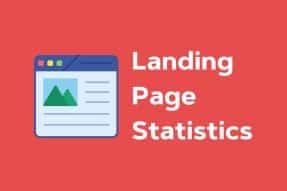



Comments (0)